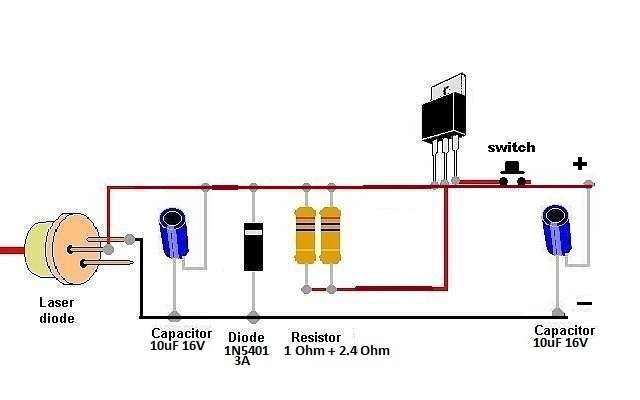jayrob
0
- Joined
- Sep 21, 2007
- Messages
- 9,862
- Points
- 113
I wanted to post a thread on this subject, because over that past couple of days, I have seen some posts that have said that there is no reason to use a FlexModP3 driver.
But there are some huge differences as discussed below...
How to build your own 445 high output driver.
I edited this drawing with the information for 1.6 Amps, or 1.8 Amps:
Here's the LM1085:
http://parts.digikey.com/1/parts/614...t-12-nopb.html

The LM1085 has a low drop out voltage, but you will still need 3 X Li-Ion's with a blu-ray or a 445...
You can expect that the over all drop out voltage for the completed circuit will end up requiring 3 X Li-Ion's for your supply if using it for a blu-ray or a 445...
For a high ouptup 445 build, 2 X Li-Ion's will work at full charge, but the circuit will not keep in regulation for the capacity of your batteries. (as they drain, the set current will not stay in regulation with only 2 X Li-Ions)
Because the other components also have some voltage draw from the supply. Not just the 1085...
I think the silicon diode has a 1 volt drop out.
I hope I'm wrong, but I seriously doubt that we can match drlava's FlexModP3. (Only needing 1.5 volts above diode demand)
With a FlexModP3, you can use 2 X Li-Ion's in a 445 build, or even a 405 build, and up to 4 Amps output! (future proof)
Take a look at my Maglite kit...
The LM1085 circuit is still a great option to build for a 3 X Li-Ion set up. But if you want that kind of power using only 2 X Li-Ion's, like with a Maglite build, then you will have to go for the FlexModP3...
A couple of other things worth mentioning...
The heatsink on the FlexModP3, is some kind of non-conductive material. So that makes it easy to just heatsink it to the main sink...
But with an LM1085, it will most likely have a metalic heatsink, that must be isolated from the negative...
Also, you have a really nice pot to adjust current on a FlexModP3 driver. You get 100mA's per 1/2 turn.
See more information on the FlexModP3 here:
http://laserpointerforums.com/f42/flexmodp3-drop-module-rl-2088-frankenstein-host-61966.html
Just thought I would post this information to clear up a few things. And by all means, if I'm wrong about the needed supply, please do chime in and let everyone know how to build a circuit that can give a 445 build 2 Amps with only 2 X Li-Ions for the full capacity of the batteries!
But there are some huge differences as discussed below...
How to build your own 445 high output driver.
I edited this drawing with the information for 1.6 Amps, or 1.8 Amps:
Here's the LM1085:
http://parts.digikey.com/1/parts/614...t-12-nopb.html

The LM1085 has a low drop out voltage, but you will still need 3 X Li-Ion's with a blu-ray or a 445...
You can expect that the over all drop out voltage for the completed circuit will end up requiring 3 X Li-Ion's for your supply if using it for a blu-ray or a 445...
For a high ouptup 445 build, 2 X Li-Ion's will work at full charge, but the circuit will not keep in regulation for the capacity of your batteries. (as they drain, the set current will not stay in regulation with only 2 X Li-Ions)
Because the other components also have some voltage draw from the supply. Not just the 1085...
I think the silicon diode has a 1 volt drop out.
I hope I'm wrong, but I seriously doubt that we can match drlava's FlexModP3. (Only needing 1.5 volts above diode demand)
With a FlexModP3, you can use 2 X Li-Ion's in a 445 build, or even a 405 build, and up to 4 Amps output! (future proof)
Take a look at my Maglite kit...
The LM1085 circuit is still a great option to build for a 3 X Li-Ion set up. But if you want that kind of power using only 2 X Li-Ion's, like with a Maglite build, then you will have to go for the FlexModP3...
A couple of other things worth mentioning...
The heatsink on the FlexModP3, is some kind of non-conductive material. So that makes it easy to just heatsink it to the main sink...
But with an LM1085, it will most likely have a metalic heatsink, that must be isolated from the negative...
Also, you have a really nice pot to adjust current on a FlexModP3 driver. You get 100mA's per 1/2 turn.
See more information on the FlexModP3 here:
http://laserpointerforums.com/f42/flexmodp3-drop-module-rl-2088-frankenstein-host-61966.html
Just thought I would post this information to clear up a few things. And by all means, if I'm wrong about the needed supply, please do chime in and let everyone know how to build a circuit that can give a 445 build 2 Amps with only 2 X Li-Ions for the full capacity of the batteries!
Last edited:





